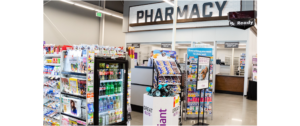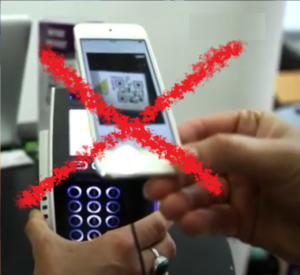An article by
Andreas Wegmann
Published on
03/12/2021
Updated on
09/11/2023
Reading time
5 min
Table of content
In point of sale retail stores there are often partnerships between companies that share a retail space. In addition to the many advantages, there are also challenges for such concepts, e.g. the payment process. With store-in-store payments, the mutual offsetting of sales should be avoided as far as possible. Here is a practical report with a new approach:
Store in Store Payments: The Pilot Project
 A pilot project will go live in 2022, in which a health insurance company wants to make the supply of reimbursable medication as easy as possible for its members. In this country the pharmacies are mostly to be found as “store-to-store” in supermarkets. So the medication is usually paid for at the supermarket checkout. Many medications are reimbursed by health insurance and the reimbursement should be made digitally with the pharmacist instead of using a paper voucher. In this case, the insured person should be able to leave the supermarket without having to queue at the supermarket checkout. At the same time, shoplifters must be prevented from taking advantage of the situation to steal items from the supermarket. So security and convenience have to be balanced so that customers, pharmacies and supermarket operators accept the concept.
A pilot project will go live in 2022, in which a health insurance company wants to make the supply of reimbursable medication as easy as possible for its members. In this country the pharmacies are mostly to be found as “store-to-store” in supermarkets. So the medication is usually paid for at the supermarket checkout. Many medications are reimbursed by health insurance and the reimbursement should be made digitally with the pharmacist instead of using a paper voucher. In this case, the insured person should be able to leave the supermarket without having to queue at the supermarket checkout. At the same time, shoplifters must be prevented from taking advantage of the situation to steal items from the supermarket. So security and convenience have to be balanced so that customers, pharmacies and supermarket operators accept the concept.
Store in Store Payments: The Requirements
 The most common use case is collecting medication that has been paid for by health insurance. The insured person receives a corresponding “voucher” in the insurance’s mobile app, which can be redeemed in selected pharmacies.
The most common use case is collecting medication that has been paid for by health insurance. The insured person receives a corresponding “voucher” in the insurance’s mobile app, which can be redeemed in selected pharmacies.
In addition, it should be possible for the insured person to buy additional medication. It must also be possible to carry out this payment process (store in store payments) in the insurance company’s mobile app. The health insurance does not want to impose a payment method on the insured, but rather allow the common payment methods in the country. In addition to the credit card, these are local online wallet payment methods and instant credit transfers from banks.
All approaches to a solution have so far failed due to the high costs, because card terminals, e.g. in connection with QR codes, should be used for the store in store payments. The acquisition of terminals, their adaptation and the installation on site make these solutions uneconomical. The handling and processing times are also unreasonable for pharmacists and customers.
Store in Store Payments: The Apparent Solution
There have been many attempts to bypass the established EFTPOS terminals by using online payment methods for cost reasons, including with store-in-store payments. The customer is directed to a payment page on his smart phone, comparable to an online shop, and authorizes the payment there. Apart from the regulatory obstacles (some online payment methods do not accept transaction at the point of sale and the merchant loses every charge back dispute), the problem of confirmation always remains for the pharmacist. Before the goods are handed over, he must be sure that the health insurance will reimburse him for the amount. Not many pharmacists want to trust the display on the customer’s smart phone because it would be too easy to manipulate.
Of course, there is also the option of checking the incoming payment on the bank account by an online banking app. To do this, however, a display device would have to be used that allows this account inspection. However, not every business owner wants to make all of his cash receipts available to his employees.
The new Principle
In the example described, the insurance company takes advantage of the fact that the insured have their smart phone with the insurance’s mobile app with them. Here, among other things, the authorizations for the medication are managed. The insured’s smart phone is used for checking and confirmation and then generates a forgery-proof receipt on the pharmacist’s printer.
The insurance company’s mobile app on the customer’s smart phone connects to a certificate server for verification. The authenticity of the voucher and the certificate of the mobile app can thus be checked beyond any doubt. The confirmation is then forwarded via Bluetooth (LE) connection to a small, commercially available printer with a Bluetooth and crypto module. If the certificates of the voucher, the smart phone and the printer match, a receipt is printed.
The receipt print is handed over to the customer together with the medication in a sealed bag. When leaving the supermarket, the seal can easily be checked visually. If the seal appears to have been tampered with, the contents of the bag can be checked against the receipt. This simple procedure effectively prevents shoplifting.
The Security
 Since the insured’s smart phone is the only connection between the health insurance system and the pharmacist’s receipt printer, there must be 100% security against manipulation. It must not be possible to change or reuse vouchers. This is guaranteed with the help of certificates that build on one another and the crypto module in the printer. The pharmacist can therefore be 100% sure that the drug dispensed will be billed for him.
Since the insured’s smart phone is the only connection between the health insurance system and the pharmacist’s receipt printer, there must be 100% security against manipulation. It must not be possible to change or reuse vouchers. This is guaranteed with the help of certificates that build on one another and the crypto module in the printer. The pharmacist can therefore be 100% sure that the drug dispensed will be billed for him.
In the event that the receipt printer is stolen, it can of course be deactivated. Anyway, misuse of a stolen printer is limited to reselling the hardware.
In the event of an additional purchase, the insurance company’s mobile app can be forwarded to any payment method that is installed on the smart phone. The only restriction here is the necessary finality of the transaction, i.e. the procedure must not allow subsequent cancellation. The insured person authorizes a payment on his smartphone in his preferred payment method and the amount is then shown on the printed receipt. Incidentally, the requirement for contactless processing is also met.
The Costs
The main cost factor of conventional concepts – a card terminal including integration – does not apply to the insurance company or the pharmacist. The administration of the vouchers takes place exclusively in the mobile app or the associated administration system. The printer can be operated as a stand alone solution and only requires a power supply and standard paper. The device costs > 100 € once. Alternatively, a built-in module can also be retrofitted in an existing printer, although this is often not likely to be economical.
A cost factor is of course the payment method used in Store in Store Payments. Credit card companies and mobile wallet operators rarely skim less than 3% of sales. In order to reduce these costs as well, the online banking apps of the local banks are to be connected step by step. The use of a cheap payment method is encouraged by the health insurance.
The Store in Store Payments with SCT Inst
Since the pilot project is taking place in a country outside the SEPA area, the possibilities of PSD2 Open Banking cannot be used there. The connection of the concept mentioned with SEPA instant payment transactions should also interest the operators of store-in-store concepts in this country. The cost advantages compared to the card terminals, along with the high processing and transaction fees, are great. In addition, high transaction amounts of up to € 100,000 are possible and the money is in the seller’s account within a few seconds without any deductions.
If you have any further questions or are interested in this concept, please use our contact form.
Share





